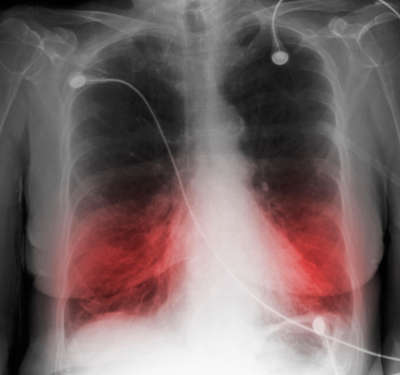Escaped protein tells a deteriorating story
The blood level of a protein produced by the lungs could indicate to doctors when chronic obstructive lung disease is deteriorating.
Published online 30 March 2016

A chest x-ray of an elderly smoker with COPD.
© Cultura RM / Alamy Stock Photo
Chronic obstructive pulmonary disease is a condition that results from chronic inflammation of the lung tissues, making it difficult to breathe. The disease progressively gets worse over time, but sometimes patients experience a sudden worsening in their symptoms, called an acute exacerbation, which can last for several days.
Researchers in Syria compared the blood levels of surfactant protein D (SP-D), a protein produced by lung cells, in 28 healthy volunteers, 28 patients with stable chronic obstructive pulmonary disease (COPD) and 28 COPD patients experiencing a sudden worsening in their condition1. They found serum SP-D levels in COPD patients experiencing an exacerbation were 1.5 times than in stable COPD patients and almost three times higher than in healthy volunteers. Levels in stable COPD patients were also almost two times higher than those in healthy subjects.
“COPD is very common in Syria but there are no published statistical studies about its prevalence in the country”, says Damascus University biochemist Alaa Zien Alaabden. Its main cause is smoking, she says, but other causes include occupational exposure and indoor pollution from cooking and heating in some rural areas.
The role of SP-D in the lung is uncertain but thought to be related to protecting the lung from inhaled pathogens. Researchers believe that changes in the permeability of diseased lung tissue result in its release into the bloodstream. There is currently no lung-specific biomarker for the diagnosis of COPD exacerbations. Since SP-D is produced by the lung, it could be used for the early diagnosis of exacerbations, says Zien Alaabden, helping physicians consider immediate treatment options.
Acute exacerbations are currently difficult to diagnose because the symptoms are subjective and their signs are often non-specific and difficult to measure. Symptoms of acute exacerbations are only weakly correlated to a decline in lung function, says Zien Alaabden. Even in advanced disease, she says, not all patients have the same symptoms. “It’s better to have a lung-specific biomarker for COPD exacerbations, especially since its symptoms may mimic other conditions”, she says.
Owing to the difficult conditions in Syria, the team was unable to test SP-D levels in a larger study sample. In the future, they hope to be able to compare levels at the start of an exacerbation and when it resolves. They also want to measure its levels inside the lung itself.
The results of this study are consistent with those of the only two studies the researchers are aware of that report on the role of SP-D in COPD exacerbations.
Reference
- Alaabden, A. Z., Mohammad, Y. & Fahoum, S. The role of serum surfactant protein D as a biomarker of exacerbation of chronic obstructive pulmonary disease. Qatar Med. J. 2015, 18 (2015). | article
DOI: 10.1038/qsh.2016.104

